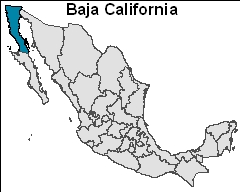
01/10/19 (written by kheinle) — Mexico experienced another record-breaking year in 2018 with high levels of crime and violence. According to data from the National Public Security System (Sistema Nacional de Seguridad Pública, SNSP), 27 of Mexico’s 32 states and Federal District saw increases in crime and violence, particularly homicides, in 2018 from 2017. That does not include data from December, notes Vanguardia. Including estimates for December’s projected results, however, SNSP predicts 2018 will close with 34,000-35,000 homicides nationwide. This punctuates the end of former President Enrique Peña Nieto’s sexenio (2012-2018) and the transition to new President Andrés Manuel López Obrador (2018-2024) on December 1, 2018.
Several states saw particularly high levels of violence in 2018, including Guanajuato, Quintana Roo, and Baja California. In the latter, homicides were largely focused in Tijuana, the border-city that has seen dramatic rises in murders the past few years. Initial estimates for 2018 show Tijuana having experienced 2,500 homicides, making it the city’s most violent year on record. As Vanguardia calculates, this equates to seven homicides every 24 hours. In 2017, Tijuana also surpassed Acapulco as the most violent municipality in Mexico, reported Justice in Mexico. This is largely because of an 85% increase in homicide cases over the course of that year. Whereas Tijuana saw 871 homicide cases in 2016, the number rose to 1,618 cases in 2017. Now with the estimated increase to nearly 2,500 homicides in 2018, it is expected to remain one of, if not the most violent municipalities in Mexico.
The New Criminal Justice System
Causes and effects of systemic issues like crime and violence are layered. One factor that plays a role, though, is the criminal justice system that a State has in place. Mexico made historic advances with the approval (2008) and implementation (2016) of the New Criminal Justice System (Nuevo Sistema de Justicia Penal, NSJP). Although the goal of the NSJP was not to reduce crime and violence, it was and is expected to do so over time. As the judiciary is fortified and judicial processes become more efficient and effective, it is anticipated to have a positive ripple effect on public security.

Several voices, however, have recently questioned the NSJP’s role in unintentionally perpetuating insecurity. Attorney José Luis Nasar Da pointed out that the modernization of the public security sector did not parallel that of the justice system. The justice system advanced quickly, while public security has not, creating a gap between the two systems. Justice lags when police and prosecutors’ ability to execute an investigation in a case does not also respect and uphold one’s presumption of innocence. Meanwhile Attorney Carlos Ordaz Rodríguez noted that criminals are able to take advantage of the holes in the justice system. He specifically pointed to the freedom and liberties many accused persons are granted while awaiting investigation and judicial processing, which are tied in with the Attorney General’s limitations in opening and expediting cases.
This connects back with the reporting on increased homicides in Tijuana, Baja California, and Mexico as a whole. As Vanguardia reports, “State and municipal authorities [in Baja California] attribute 80% of homicides to drug trafficking cases and to the New Criminal Justice System.” It continues, “[This] creates a revolving door because it allows the accused to go free even when they were detained in possession of fire arms.”
Response to Critics
In a post from May 2018 titled, “Responses to the Critics of the Judicial Reform in Mexico,” Justice in Mexico discussed the counterarguments to such criticisms leveled against the new system. Quoting Karen Silva from the Center of Investigation for Development (Centro de Investigación para el Desarrollo, CIDAC), “The [adversarial] system is not the problem; the problem is the lack of capacity among institutions.” Rather, she argues that the rise in violence can be attributed to a lack of knowledge and skill among criminal justice operators, including police, prosecutors, public defenders, and judges, which perpetuates high levels of impunity. In turn, impunity reinforces a precedent that violent crimes will go unpunished and not be investigated, and it deteriorates citizens’ faith in the judicial sector.
Hence, states across the country, including Baja California, have and continue to make significant advances in the procurement of justice under the new system. This includes the construction of new court rooms, the education and training of justice system operators, and the modernization of judicial procedures, among others to build the capacity of the institutions tasked with implementing justice.
Sources:
“Responses to the Critics of the Judicial Reform in Mexico.” Justice in Mexico. May 21, 2018.
“Registra fallas el nuevo sistema de justicia penal.” El Diario de Coahuila. December 8, 2018.
“En el gobierno ya no hay ‘golondrinas en el alambr’: López Obrador.” Informador. December 19, 2018.
“Usan los delincuentes hueco en código penal.” El Diario de Coahuila. January 3, 2019.




